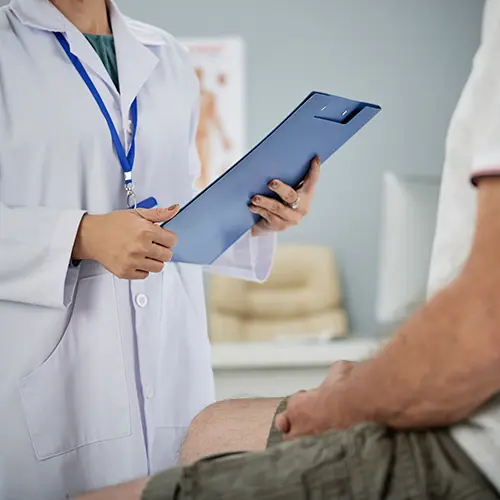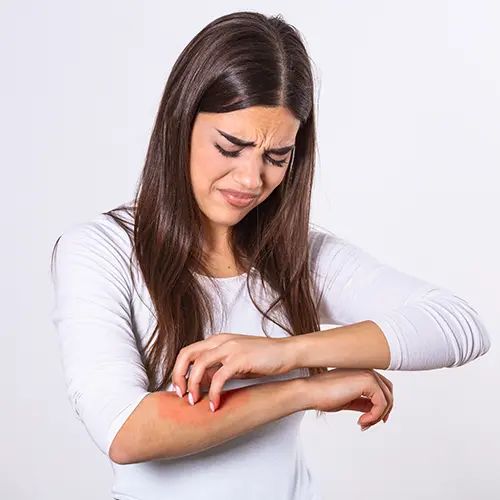Table of Contents
Caring for a child's skin health is a vital aspect of parenting, yet it can often be an area filled with uncertainties and concerns. Pediatric dermatology is a specialized field that addresses the unique skin needs of infants, children, and adolescents.
In this article, we delve into the importance of nurturing and protecting young, sensitive skin.
We discuss common skin conditions that children may encounter, from the familiar diaper rash and eczema to more complex issues like birthmarks and skin infections.
The article emphasizes the significance of early diagnosis and proper treatment, highlighting how pediatric dermatologists play a crucial role in ensuring healthy skin development.
We also provide practical tips for parents on everyday skincare routines, sun protection, and when to seek professional help.
This piece aims to equip parents with knowledge and confidence, ensuring that they are well-prepared to care for their child's dermatological health through various stages of growth.
When should my child see a Pediatric Dermatologist?
Your child should see a pediatric dermatologist if they have any skin conditions or concerns that require specialized care beyond what a primary care physician or general dermatologist can provide. Some situations that may warrant a visit to a pediatric dermatologist include:
Persistent or severe skin conditions: If your child has a skin condition such as eczema, psoriasis, acne, or a fungal infection that is not responding well to treatment or is causing significant discomfort, a pediatric dermatologist can offer specialized care and treatment options.
Birthmarks or moles: If your child has birthmarks, moles, or other pigmented lesions that are changing in size, shape, or color, it's important to have them evaluated by a pediatric dermatologist to rule out any potential concerns such as skin cancer or other serious conditions.
Hair and scalp disorders: Pediatric dermatologists can diagnose and treat various hair and scalp disorders in children, including alopecia (hair loss), dandruff, and scalp infections.
Allergic reactions: If your child experiences severe allergic reactions such as hives, contact dermatitis, or drug reactions that affect the skin, a pediatric dermatologist can help identify the triggers and provide appropriate treatment.
Chronic or recurring skin infections: Children who experience frequent or chronic skin infections such as impetigo, cellulitis, or fungal infections may benefit from evaluation and management by a pediatric dermatologist to prevent future recurrences.
Skin conditions associated with underlying medical conditions: Some skin conditions may be associated with underlying medical conditions or genetic syndromes. A pediatric dermatologist can help diagnose and manage these complex cases in coordination with other specialists as needed.
Overall, if you have concerns about your child's skin health or if they are experiencing any persistent or unusual skin symptoms, it's best to consult with a pediatric dermatologist for expert evaluation and care tailored to their specific needs. Your child's primary care physician can provide a referral if necessary.
What are common skin conditions in children?
Common skin conditions in children can vary widely, but some of the most frequently encountered ones include:
Eczema (Atopic Dermatitis): A chronic inflammatory skin condition characterized by dry, itchy, and inflamed skin. It often appears as patches of red, scaly skin, particularly in flexural areas like the elbows and knees.
Diaper Rash: Irritation of the skin in the diaper area, usually caused by prolonged contact with urine and feces, friction, or sensitivity to certain diaper materials or products.
Acne: A common skin condition characterized by the presence of pimples, blackheads, whiteheads, and sometimes deeper cysts or nodules. Acne typically appears on the face, but it can also affect the back, chest, and shoulders.
Molluscum Contagiosum: A viral skin infection characterized by small, raised bumps with a central indentation. It's highly contagious and often affects children, especially those in close contact with one another.
Impetigo: A bacterial skin infection that causes red sores or blisters, typically around the nose and mouth, but can occur anywhere on the body. The sores can rupture and develop a yellow-brown crust.
Ringworm (Tinea): A fungal infection that causes a red, circular rash with raised edges. It can occur on the scalp (tinea capitis), body (tinea corporis), feet (tinea pedis, or athlete's foot), or groin area (tinea cruris, or jock itch).
Warts: Benign skin growths caused by the human papillomavirus (HPV). Warts can appear anywhere on the body but are common on the hands, feet, and face.
Miliaria (Heat Rash): Tiny, red bumps that develop when sweat becomes trapped in the sweat ducts during hot, humid weather. It often occurs in areas covered by clothing.
Hives (Urticaria): Raised, itchy welts on the skin that can vary in size and shape. Hives are often caused by an allergic reaction but can also result from infections, medications, or other triggers.
Psoriasis: A chronic autoimmune condition characterized by thick, red, scaly patches on the skin. Psoriasis can affect children of any age and often appears on the scalp, knees, elbows, and lower back.
These are just a few examples of common skin conditions in children. It's important to consult with a healthcare professional for proper diagnosis and treatment if your child is experiencing any skin issues.
How can I prevent diaper rash?
Preventing diaper rash involves keeping the diaper area clean, dry, and protected from irritants. Here are some tips to help prevent diaper rash in your child:
Change diapers frequently: Change your baby's diapers as soon as they are wet or soiled. Leaving a wet or dirty diaper on for too long can increase the risk of diaper rash.
Clean the diaper area gently: Use a soft cloth or baby wipes to gently clean your baby's diaper area during diaper changes. Avoid using wipes or cleansers with harsh chemicals or fragrances that may irritate the skin.
Allow the skin to air dry: After cleaning your baby's diaper area, pat it dry with a clean cloth and allow the skin to air dry completely before putting on a fresh diaper.
Use a barrier cream or ointment: Apply a thin layer of a diaper rash cream or ointment containing zinc oxide or petroleum jelly to your baby's clean, dry skin before putting on a new diaper. This creates a protective barrier that helps prevent moisture from irritating the skin.
Choose diapers carefully: Opt for diapers that are breathable and absorbent to help keep your baby's skin dry. Consider trying different diaper brands or styles if you notice frequent diaper rashes.
Avoid tight-fitting diapers and clothing: Dress your baby in loose-fitting clothing that allows air to circulate freely around the diaper area. Tight diapers or clothing can trap moisture and increase the risk of diaper rash.
Be mindful of potential irritants: Avoid using harsh soaps, lotions, or powders in the diaper area, as they can irritate the skin. Stick to gentle, fragrance-free products formulated specifically for babies.
Give diaper-free time: Allow your baby to go diaper-free for short periods throughout the day to give their skin a chance to breathe and reduce moisture buildup.
Monitor for signs of irritation: Keep an eye on your baby's diaper area for any signs of redness, irritation, or rash. If you notice any changes, take steps to address them promptly to prevent diaper rash from worsening.
By following these preventive measures and keeping your baby's diaper area clean, dry, and protected, you can help reduce the risk of diaper rash and keep your baby comfortable.
Is sunscreen necessary for children?
Yes, sunscreen is necessary for children to protect their delicate skin from the harmful effects of the sun's ultraviolet (UV) rays. Children's skin is more sensitive and prone to damage from sun exposure than adult skin, making sunscreen an essential part of sun protection for kids.
Here are several reasons why sunscreen is important for children:
Protection against sunburn: Sunburns during childhood can significantly increase the risk of developing skin cancer later in life. Using sunscreen with a high SPF helps prevent sunburn and reduces the risk of long-term skin damage.
Reduced risk of skin cancer: Regular use of sunscreen in childhood can help lower the risk of developing skin cancer, including melanoma, later in life. UV exposure during childhood and adolescence is a significant risk factor for skin cancer.
Prevention of skin damage: Sunscreen helps protect children's skin from UV radiation, which can cause premature aging, wrinkles, and other signs of sun damage over time.
Lower risk of other skin problems: Sunscreen can help prevent other sun-related skin problems in children, such as sun rashes, sun allergies, and sun blisters.
When selecting sunscreen for children, it's important to choose a broad-spectrum sunscreen with SPF 30 or higher that offers protection against both UVA and UVB rays. Additionally, look for sunscreens that are specifically formulated for children's sensitive skin and are free of harsh chemicals and fragrances that may cause irritation.
In addition to using sunscreen, parents should encourage other sun protection measures for their children, such as wearing protective clothing, hats, and sunglasses, seeking shade during peak sun hours, and avoiding tanning beds. By incorporating sunscreen and other sun safety practices into their routine, parents can help protect their children's skin from sun damage and promote long-term skin health.
What should I do about my child's eczema?
Managing eczema in children involves a combination of skincare practices, lifestyle adjustments, and sometimes medical treatment. Here are some steps you can take to help manage your child's eczema:
Keep the skin moisturized: Moisturizing is essential for managing eczema. Use a gentle, fragrance-free moisturizer or emollient cream regularly, especially after bathing, to help keep your child's skin hydrated and prevent flare-ups.
Avoid irritants: Identify and avoid triggers that can irritate your child's skin and worsen eczema symptoms. Common irritants include harsh soaps, fragrances, certain fabrics (such as wool), and environmental factors like dry air and extreme temperatures.
Use gentle cleansers: Choose mild, fragrance-free cleansers or soap substitutes when bathing your child. Avoid hot water, which can dry out the skin, and opt for lukewarm water instead. Limit baths to 10-15 minutes, and pat the skin dry with a soft towel afterward.
Dress in soft, breathable fabrics: Dress your child in loose-fitting clothing made from soft, breathable fabrics like cotton to minimize irritation and allow the skin to breathe.
Manage itching: Help your child manage itching by keeping their nails short to prevent scratching and using cool compresses or anti-itch creams as needed. Encourage your child to avoid scratching, as it can further damage the skin and lead to infections.
Maintain a consistent skincare routine: Establish a regular skincare routine for your child, including moisturizing, bathing, and applying any prescribed medications. Consistency is key to managing eczema symptoms effectively.
Identify and manage triggers: Keep track of any factors that seem to trigger your child's eczema flare-ups, such as certain foods, environmental allergens, or stress. Take steps to minimize exposure to these triggers whenever possible.
Seek medical treatment when necessary: If your child's eczema is severe or not responding to home remedies, consult a pediatrician or dermatologist for further evaluation and treatment. They may prescribe topical corticosteroids, calcineurin inhibitors, or other medications to help control inflammation and itching.
Consider allergy testing: In some cases, eczema may be associated with food allergies or environmental allergens. If you suspect that your child's eczema is triggered by allergies, talk to their healthcare provider about allergy testing and potential dietary or environmental modifications.
Monitor for signs of infection: Keep an eye on your child's eczema-prone areas for signs of infection, such as increased redness, swelling, warmth, or drainage. If you suspect an infection, seek medical attention promptly for appropriate treatment.
By following these steps and working closely with your child's healthcare provider, you can help manage their eczema effectively and improve their quality of life.
Can children get acne?
Yes, children can get acne. While acne is most commonly associated with adolescence and puberty, it can occur at various stages of childhood as well. Pediatric acne typically appears between the ages of 8 and 12, although it can develop in younger children as well.
There are two main types of acne that can affect children:
Comedonal acne: This type of acne is characterized by the presence of comedones, which are non-inflammatory lesions commonly known as whiteheads and blackheads. Comedonal acne may appear on the face, particularly on the forehead, nose, and chin, as well as on the chest and back.
Inflammatory acne: Inflammatory acne involves red, swollen, and tender lesions such as papules, pustules, and nodules. These lesions occur when the hair follicles become inflamed due to bacterial overgrowth and inflammation.
Several factors can contribute to the development of acne in children, including hormonal changes, genetic predisposition, environmental factors, and certain medications or skincare products. Additionally, children may experience acne as a result of increased oil production, clogged pores, and bacteria on the skin.
Managing acne in children typically involves gentle skincare practices, such as washing the affected areas with a mild cleanser twice daily and avoiding harsh or abrasive products that can irritate the skin. In some cases, a pediatrician or dermatologist may recommend over-the-counter or prescription medications to help control acne symptoms, such as topical retinoids, benzoyl peroxide, or antibiotics.
It's essential for parents to support their children emotionally and provide reassurance during this time, as acne can have a significant impact on self-esteem and body image, especially in children. Encourage your child to maintain good skincare habits, eat a balanced diet, and avoid picking or squeezing acne lesions, which can lead to scarring and further inflammation.
If your child's acne is severe, persistent, or causing distress, consult a healthcare provider for further evaluation and personalized treatment recommendations. With proper care and management, acne in children can be effectively controlled, and your child can enjoy clear, healthy skin.
FAQ
What is Pediatric Dermatology?
Pediatric dermatology is a specialized field focusing on the diagnosis and treatment of skin conditions in infants, children, and adolescents. This includes common issues like eczema, acne, and birthmarks, as well as more complex skin disorders.
When should my child see a Pediatric Dermatologist?
Consider a visit to a pediatric dermatologist if your child has persistent skin problems, unusual or severe rashes, birthmarks, or any skin changes that worry you. Early intervention can be key in treating many skin conditions.
What are common skin conditions in children?
Common conditions include eczema (atopic dermatitis), diaper rash, warts, acne, birthmarks, and skin infections. These can range from mild to severe and may require specialized care.
How can I prevent diaper rash?
To prevent diaper rash, keep your baby's skin clean and dry, change diapers frequently, and use a barrier cream or ointment. Avoid wipes with alcohol or fragrance if your child's skin is sensitive.
Is sunscreen necessary for children?
Absolutely. Children's skin is sensitive to sun damage. Use a broad-spectrum sunscreen with an SPF of at least 30, and apply it generously and frequently, especially if your child is swimming or sweating.
What should I do about my child's eczema?
For eczema, keep your child's skin moisturized, avoid irritants like harsh soaps, and follow any treatment plans provided by your pediatric dermatologist. Sometimes, medicated creams or lifestyle changes may be recommended.
Can children get acne?
Yes, children, especially teenagers, can develop acne. Gentle skin care and, in some cases, medications can help manage acne. A dermatologist can provide guidance tailored to your child's specific needs.
Are birthmarks dangerous?
Most birthmarks are harmless, but some may require monitoring or treatment. If a birthmark changes in size, shape, or color, it should be evaluated by a pediatric dermatologist.
How do I choose the right skincare products for my child?
Look for products formulated for sensitive skin, free from fragrances, dyes, and harsh chemicals. Your pediatric dermatologist can recommend products suitable for your child's specific skin type and condition.
When do skin conditions warrant emergency care?
Seek emergency care if your child has a sudden, severe rash, especially if accompanied by fever or other signs of illness, or if there is a rapid spread of skin infection.




















